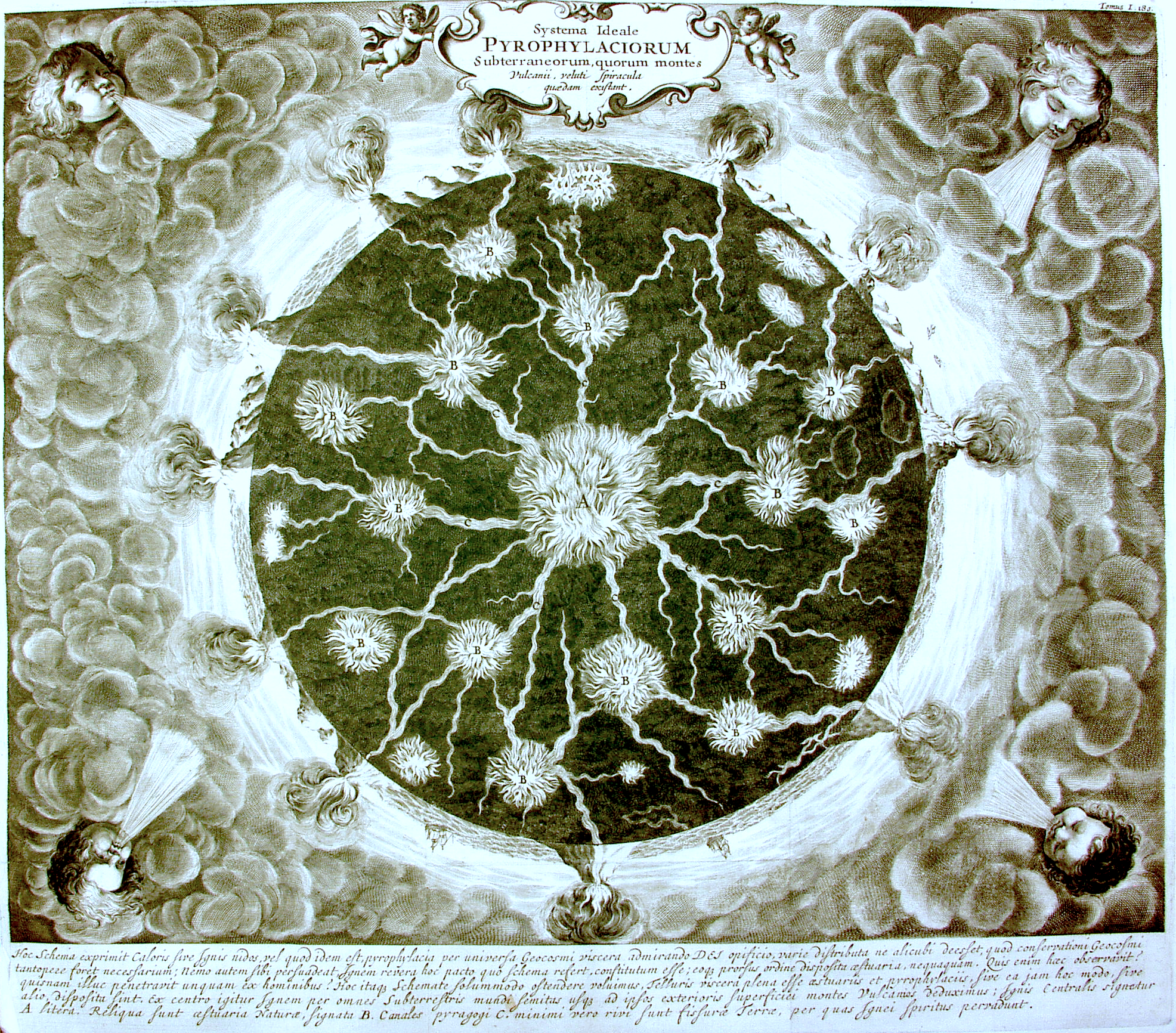Litho 1.0 global sampling¶
Here we show how to extract information on depths of particular interfaces in the model at any point and the mechanism by which this is implemented in the wrapper.
We also demonstrate the mechanism to query a depth profile at any lon/lat location and therefore how to construct a depth profile along a great circle.
import litho1pt0 as litho
from pprint import pprint as pprint
import numpy as np
%matplotlib inline
import matplotlib.pyplot as plt
import cartopy
import cartopy.crs as ccrs
import pyproj
import stripy
pprint(" Layer keys")
pprint( litho.l1_layer_decode.items() )
pprint(" Value keys")
pprint( litho.l1_data_decode.items() )
lats = np.array([0,0,0,0])
lons = np.array([10,10,10,10])
depths = np.array([1, 20, 100, 1000 ])
C, Vp = litho.property_at_lat_lon_depth_points(lats, lons, depths, quantity_ID='VP')
print (C)
print (Vp)
## Checking the integrity
nlayers = len(litho.l1_layer_decode)
layer_depths = np.empty((nlayers, lats.shape[0]))
layer_properties = np.empty((nlayers, lats.shape[0]))
for i in range(0, nlayers, 1 ):
layer_depths[i], err = litho._interpolator.interpolate(lons * np.pi / 180.0, lats * np.pi / 180.0,
litho._litho_data[i,litho.l1_data_decode["DEPTH"]], order=1)
layer_properties[i], err = litho._interpolator.interpolate( lons * np.pi / 180.0, lats * np.pi / 180.0,
litho._litho_data[i,litho.l1_data_decode["DENSITY"]], order=1)
print (layer_depths)
print (layer_properties)
## make a global raster of some quantity
lonv, latv = np.meshgrid(np.linspace(-180,180,360), np.linspace(-90,90,180), sparse=False, indexing='xy')
l1 = litho.layer_depth(latv, lonv, "LID-BOTTOM")
l2 = litho.layer_depth(latv, lonv, "LID-TOP")
lthickness = (l1 - l2)*0.001
l1 = litho.layer_depth(latv, lonv, "CRUST3-BOTTOM")
l2 = litho.layer_depth(latv, lonv, "CRUST1-TOP")
cthickness = (l1 - l2)*0.001
# density at 1km depth
depths = np.ones_like(lonv, dtype=np.float)*5.0
ids, density_at_1km = litho.property_at_lat_lon_depth_points(latv, lonv, depths, quantity_ID="DENSITY")
%matplotlib inline
import cartopy
import gdal
import cartopy.crs as ccrs
import matplotlib.pyplot as plt
projection1 = ccrs.Orthographic(central_longitude=140.0, central_latitude=0.0, globe=None)
projection2 = ccrs.Mollweide(central_longitude=0)
base_projection = ccrs.PlateCarree()
global_extent = [-180.0, 180.0, -90.0, 90.0]
fig = plt.figure(figsize=(12, 12), facecolor="none")
ax = plt.subplot(111, projection=projection2)
ax.coastlines()
ax.set_global()
m = ax.imshow(density_at_1km.reshape(-1,360), origin='lower', transform=base_projection,
extent=global_extent, zorder=0, cmap="Blues")
plt.colorbar(mappable=m, orientation="horizontal", shrink=0.5)
def great_circle_profile(startlonlat, endlonlat, depths, resolution, QID):
"""
model: self
ll0: (lon0, lat0)
ll1: (lon1, lat1)
depths (km)
resolution: separation (km) of locations to sample along the profile
"""
import stripy
lons, lats = great_circle_Npoints(np.radians(startlonlat), np.radians(endlonlat), 1000)
## Would be useful to have distance measure here to map resolutions ...
data = np.empty( (lons.shape[0], depths.shape[0]))
for s, ll in enumerate(lons):
c, profile = litho.property_on_depth_profile(np.degrees(lats[s]), np.degrees(lons[s]), depths, QID)
data[s,:] = profile[:]
return np.degrees(lons), np.degrees(lats), data
def great_circle_Npoints(lonlat1, lonlat2, N):
"""
N points along the line joining lonlat1 and lonlat2
"""
ratio = np.linspace(0.0,1.0, N).reshape(-1,1)
lonlat1r = np.radians(lonlat1)
lonlat2r = np.radians(lonlat2)
xyz1 = np.array(stripy.spherical.lonlat2xyz(lonlat1r[0], lonlat1r[1])).T
xyz2 = np.array(stripy.spherical.lonlat2xyz(lonlat2r[0], lonlat2r[1])).T
mids = ratio * xyz2 + (1.0-ratio) * xyz1
norm = (mids**2).sum(axis=1)
xyzN = mids / norm.reshape(-1,1)
lonlatN = stripy.spherical.xyz2lonlat( xyzN[:,0], xyzN[:,1], xyzN[:,2])
return np.degrees(lonlatN)
depths = np.linspace(-10.0, 250, 100)
startlonlat=np.array([80.0,5.0])
endlonlat =np.array([80.0,45.0])
midlonlat = 0.5 * ( startlonlat + endlonlat)
lons, lats, d = great_circle_profile(startlonlat, endlonlat, depths, 2.5, "DENSITY")
lonlat1r = np.radians(startlonlat)
lonlat2r = np.radians(endlonlat)
xyz1 = np.array(stripy.spherical.lonlat2xyz(lonlat1r[0], lonlat1r[1])).T
xyz2 = np.array(stripy.spherical.lonlat2xyz(lonlat2r[0], lonlat2r[1])).T
N=100
ratio = np.linspace(0.0,1.0, N).reshape(-1,1)
mids = ratio * xyz2 + (1.0-ratio) * xyz1
fig = plt.figure(figsize=(7, 7), facecolor="none")
ax = plt.subplot(111, projection=ccrs.Orthographic(central_latitude=midlonlat[1], central_longitude=midlonlat[0]))
ax.set_global()
ax.add_feature(cartopy.feature.OCEAN, alpha=1.0, facecolor="#BBBBBB", zorder=0)
ax.scatter(lons, lats, transform=ccrs.PlateCarree(), zorder=100)
ax.coastlines()
# Compute some properties about the profile line itself
drange = depths[-1] - depths[0]
#
# Cross section
#
fig = plt.figure(figsize=(12, 12), facecolor="none")
ax = plt.subplot(211)
ax2 = plt.subplot(212, projection=ccrs.Orthographic(central_latitude=midlonlat[1],
central_longitude=midlonlat[0]))
image = d[:,:]
m1 = ax.imshow(image.T, origin="upper", cmap="plasma", aspect=5.0, vmin=2000, vmax=3000)
plt.colorbar(mappable=m1, )
#
# Map / cross section
#
ax2.set_global()
global_extent = [-180.0, 180.0, -90.0, 90.0]
m = ax2.imshow(cthickness, origin='lower', transform=ccrs.PlateCarree(),
extent=global_extent, zorder=0, cmap="Oranges")
ax2.add_feature(cartopy.feature.OCEAN, alpha=0.25, facecolor="#BBBBBB")
ax2.coastlines()
lonr, latr = great_circle_Npoints(np.radians(startlonlat), np.radians(endlonlat), 10)
ptslo = np.degrees(lonr)
ptsla = np.degrees(latr)
ax2.scatter (ptslo, ptsla, marker="+", s=100, transform=ccrs.PlateCarree(), zorder=101)
